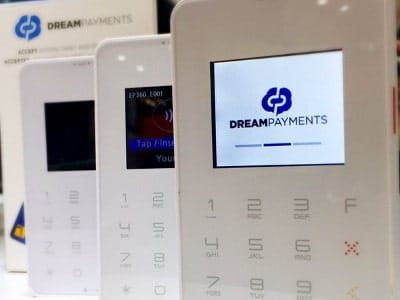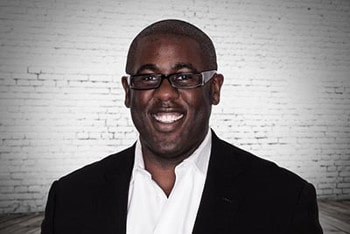
 Toronto mobile point-of-sale developers Dream Payments unveiled their EMV MPOS business solution at Retail’s Big Show in New York recently.
Toronto mobile point-of-sale developers Dream Payments unveiled their EMV MPOS business solution at Retail’s Big Show in New York recently.
With the new EMV (Europay Mastercard Visa) chip-and-pin requirements coming online in the United States, retailers big and small are scrambling to comply, with mixed results.
As opposed to building a financial services brand from scratch and taking on the big financial institutions (FIs) from a start-up perspective, Dream Payments has partnered with a Canadian banking partner and TELUS, for distribution of its physical product through TELUS retail outlets, and is looking to partner with other large American financial institutions to scale their offerings North America-wide, much as they have already done in Canada.
The ability of Dream Payments to partner with anyone from large financial institutions to mobile providers to other point-of-sale platforms is its great strength, as it means that none of them have to reinvent the wheel from scratch, but can leverage each others’ strengths to build a more robust offering.
Cantech Letter sat down with Dream Payments CEO Brent Ho-Young and CFO Alex Walker recently in Toronto.
What’s the Dream Payments story?

Brent Ho-Young: In a nutshell, Dream is focused on providing digital financial services to business customers of all sizes, but in partnership with large financial institutions. A major Canadian bank is one of our key partners. Also, entities that have relationships with business customers. So TELUS, for example, the mobile operator, has fantastic relationships with businesses to whom they provide mobile services. So we are leveraging their relationships, as well. The real core of it is that we look at all these disruptive start-ups that are out there trying to attack and disintermediate banks and large financial service providers. We have built an entire cloud that’s secure, supports EMV, is PCI compliant. It’ll support payment services today, and then we’re also looking to roll out value-added services, as well. It can be lending services, it can be analytics, or point-of-sale, to build an ecosystem that our partner FIs can draft off of. So they don’t need to go and invest and try to compete themselves. We allow them to do what they do best, servicing their core customers with products and services that we are building. An ecosystem of partnerships.
What’s your relationship with TELUS? Are you offered on their Internet of Things platform?
Brent Ho-Young: No. We’ve built our own cloud. The great thing about that for TELUS is that they can essentially just market our services through their channels, and that’s done both online and through retail. But a customer can sign up using our mobile application capability or on the web. They can purchase our payment solution through TELUS. But from TELUS’ perspective, they don’t do any other web thing or need to provide any other technology to support the offering.
So it can be a white label thing?

Brent Ho-Young: Absolutely.
Alex Walker: It depends ultimately on what the partner wants. We have a whole stack of capabilities that they can pick and choose from. They can choose to use a brand like Dream Payments, or they can choose their own brand and white label it, or we can white label it to any brand they want.
And you’ve got a big financial services partner waiting in the wings?
Brent Ho-Young: Exactly. And that’ll be a complete white label deal. We’re essentially looked at as a technology provider or enabler for them. And they’re going to do the distribution and sales and marketing while we power the solution.
What’s your background?
Brent Ho-Young: Previous to Dream, which was formulated a couple years ago, I was co-founder of another company, a technology and software development firm that worked on behalf of financial services companies like Western Union. So we built all their mobile financial service offerings, worked around the world in developing markets as well, things like M-Pesa, which is probably the leading mobile money service in the developing world. In that work, we built out a robust technology platform that we would use to deliver our offerings to our partner institutions. And then as part of that journey, we decided that we could focus on this mobile merchant acceptance standpoint and use our core technology that had already been built out, and we could customize that for what we’re doing in the developed world here. We decided to actually spin that platform, that segment of the business, into a separate entity and to capitalize that. The other business was a partnership, and we wanted capital and to grow this at scale. We partnered with Alex’s company at the time, Kili Technology, which you may have heard of. They actually were acquired by Square. And we did a partnership where Alex was the co-CEO there, where they provided the hardware for payment terminals. They had really innovative chip sets, very low cost mobile terminals. And we provided the core processing cloud platform, and integration into the banks.
What’s the payment processing space like? Is it friendly or is everyone rivals? Is it a typical path for fintech companies to be acquired by larger players?
Brent Ho-Young: It’s an attractive acquisition target. Because if you think of the transformation that is happening across North America, but the U.S. also, as they move to EMV cards and acceptance, there haven’t been many start-up platforms that were robust enough and also supported the ability to accept EMV, mobile, contactless, basically all forms of modern payment. So I think there is probably going to be a few more acquisitions happening over the next 18 months, because whether it be the Verifones, some of the other large acquirers, they’re all trying to make the transition to both EMV and mobility. Lastly, one thing that’s coming up more and more is third-party app ecosystems. I can provide a payment solution, the hardware and the back-end processing, but these businesses want that consumer experience. They want to be able to run most of their business either on their mobile or have an elegant integration path to analytics, loyalty and rewards and things like that.
So that’s highly configurable on the merchant’s end, enabling the analytics and all that?
Brent Ho-Young: Yeah, without having to build out a bunch of custom integration and technology. We’re working on a partnership with an accounting software provider that would allow a Dream customer to associate their accounting software account to the Dream servers. So automatically any transaction that happened through the Dream platform would be replicated within the accounting package. So if you’re a small business, you don’t have to download in the night your CSV files and upload those into your accounting software. That would be automatically represented.
[The banks] don’t need to go and invest and try to compete themselves. We allow them to do what they do best, servicing their core customers with products and services that we are building. An ecosystem of partnerships. – Dream Payments CEO Brent Ho-Young
How do you fit into the e-Commerce ecosystem, where Shopify is for online sales and Lightspeeed is more geared towards restaurants and brick-and-mortar retail?
Brent Ho-Young: Lightspeed is a great example. I just met with them at the NRF show down in New York. We look at Lightspeed as being a vertical expert in point-of-sale. They don’t offer payments themselves. We would use our API to integrate to them. So any Lightspeed merchant or retailer or restaurant could be able to have a completely integrated Lightspeed point-of-sale, plus the payments, completely turnkey.
Alex Walker: They’d be able to access the whole Dream ecosystem, too. They could get other mobile financial services, as well, like merchant advances and things like that. So by adding a Lightspeed to our ecosystem, you allow their merchants to be able to access the ecosystem. Also, our merchants get to take advantage of the stickiness of their app. Our banks love it, because the thing that they’re always competing on is MDR, or merchant discount rate. How cheap is your processing? This allows them to actually get stickiness at the merchant level, so they’re not always getting bumped out for the next best payments company because their rate is 2%. So yeah, Lightspeed is a great partner, like a Shopify. Exactly the same thing again. They’re a very similar, vertical specific application provider that allows us to offer stickiness, and we do get distribution potentially from them as well.
And Lightspeed is also highly specialized in the Mac ecosystem, whereas I get the impression that you guys are device agnostic.
Brent Ho-Young: Yeah, whatever platforms that the merchants want, that’s what we support. We look at Lightspeed, Shopify and TouchBistro as the partners that we want to deliver into our ecosystem to provide value to their businesses or merchants. If you think about it, it’s like our model where we distribute through TELUS, this is the first payment terminal that’s going to be sold in a retail environment that accepts Interac, debit, and chip cards. So our vision is, we would have “Lightspeed enabled” or “Shopify enabled” printed right here on our solution. So someone that’s walking in, they may be a Lightspeed customer today, or they might say, ‘Hey, you know what? Your Dream point-of-sale is very limited, it’s not specialized to my industry. But, hey, I’ve heard about Lightspeed.’ I can pick this up, purchase it, activate it, and then also light up Lightspeed within minutes, too.
Alex Walker: What’s really cool, too, is that our product is distributed in retail. So for Lightspeed, it gives retail distribution to their product, as well. They can’t really distribute in retail right now because they don’t have any form factor to distribute it on. So now, if we say “Lightspeed enabled”, Lightspeed will be distributed in every TELUS store across Canada, which is really powerful for them.
Right, because they’re not at all a brick-and-mortar operation.
Alex Walker: Right, say a customer is at a TELUS store looking for an iPhone or a charger, he looks over and sees Lightspeed. Now he can pick that up and automatically integrate Lightspeed and Dream, as well.
Historically, the banking sector has not exactly been renowned for its agility. But lately, it seems like it’s waking up and responding to so-called disruptors who threaten their business. Are you finding that the banks are buying to that idea?
Brent Ho-Young: Absolutely. In a big way. That’s one of the things I’m most proud of, is the fact that, if you think about it, it’s the first time where a bank, a mobile operator and a fintech start-up have partnered and jointly worked together on a true value creation. And it’s a revenue sharing partnership, too. So we’re all incented to do what we do best. TELUS, from their understanding of their business customers and the relationships that they have and the retail footprint that they have, too. For a bank to compete, to build up retail branches, if anything they’re diminishing the size of their retail footprint. But we’re leveraging that retail footprint that TELUS has. We’ve spent a lot to build up our core technology and integrate it into a bank, and unleash a lot of the capacity that that bank has. The bank has its core processing infrastructure, it’s secure, and they have fantastic compliance and risk management protocols. As a small company, just to build that all, you could be like Square and raise $700 million to do that and build a brand, or you can take the best of each of these partners and put that together. I think that’s a very compelling offering.
What’s in the future for Dream Payments?
Brent Ho-Young: We launched in Canada, got good support from the large FIs and mobile operators. And so the next chapter of the journey will be to expand into the U.S. We’ll be launching in the U.S. in the Q4 timeframe. We’ve got some good partnerships for our expansion. Some of the uniqueness about working in Canada is that people say there’s not a lot of players, and it’s tough to get commercial frameworks done and things like that. But once you have that base, and you’ve proven yourself, then in terms of scalability to the U.S. or internationally, you can do that.
We don’t want to disintermediate the banks. We want to assist them and all the other branded players in the market to leverage their capabilities, because nobody is building really good, secure mobile financial service capabilities. – Dream Payments CFO Alex Walker
Right, the Canadian and U.S. markets are basically pretty similar, except for size.
Alex Walker: A lot of the banking requirements and compliance stuff is very similar. There are some things that are a little bit unique but I’d say that for the U.S., our cloud is for the most part ready to go. We literally just have to use our distribution partners and do a few things around some U.S.-specific requirements. But we’ve largely built out the technology for this business, and now it’s really more about scaling to commercialize it than it is about the technology.
And if you’re partnering with a major player, scaling becomes less of a challenge.
Alex Walker: It’s been so cool for our Canadian banking partner, because they were pretty excited about this. We launched very late in October, and we have merchants now in how many Canadian cities?
Brent Ho-Young: Over 100 cities across Canada.
Alex Walker: And our Canadian banking partner hasn’t had to lift a finger to acquire these merchants. So the retail distribution model, the online and over-the-counter distribution model we’ve created for this is really impressing our partners. And the numbers per retail store that we’re seeing, merchants just coming in and picking up these devices, is higher than we originally expected, as well. Plus, online. And we haven’t even activated the TELUS SMB network yet. They won’t activate that until probably late February. And once you get an SMB force selling the product, we’re going to start seeing larger merchants bring this on, as well. A lot of the development that we’re doing today is to broaden the features, and add devices like scanners and bluetooth printers and things like that, there’s so much stuff that we can keep building out, to go deeper into merchants from a vertical perspective and to offer more digital financial services, like loan origination and credit. When you think about this platform, what it does really well is it adjudicates or onboards a person, and delivers a digital financial service to that person securely. So you can imagine that most requirements in a fintech platform, banking, credit, loan origination, insurance, merchant acquiring, go down the list can be delivered by our cloud. We were just looking at a study from a large North American FI, which states that it can cross-sell six more financial services to a small business customer once they sell the first. So they’re looking at it as a cross-sell platform.
So the banks are looking at you as a way to get into the disruption game themselves.
Alex Walker: That’s what I think is important to banks is to say, ‘Look, we haven’t traditionally been very good at all at partnering with small tech start-ups. Why don’t we go deep with you guys with respect to this? We’ll start some small, really deep partnership stuff, and then use this and replicate it, not necessarily with you guys, but with other players.’ So they can then build out their entire technology strategy. Like most North American banks, they’re spending a lot of money on trying to figure out what the best way to launch a technology strategy is. We’re from the technology world, so how do you launch a technology strategy? You get a few coders and away you go. It’s not that hard. But the banks are not really equipped to move quickly with this stuff. And then they get lapped by all the other small fintech guys that are killing it.
Brent Ho-Young: We’re seeing the attitudes change. Our Canadian banking partner is a great example of where you can do everything in-house or you can focus on what you do really well, open up that API ecosystem, work with a fintech start-up and then deliver a more compelling offering that’s more secure, much quicker and more capital efficient than if you did that on your own.
For consumers, there’s the matter of trust and brand awareness.
Alex Walker: Square has spent $750 million building a fintech brand. A brand that you as a consumer would recognize and say, ‘I want to use this.’ Well, you know, the incumbent banks, they’ve got great brands. I mean, do you really need to spend three-quarters of a billion dollars building a brand and a distribution force, or do you want to spend not even close to that building great technology and partnering with the right firms? We don’t want to disintermediate the banks. We want to assist them and all the other branded players in the market to leverage their capabilities, because nobody is building really good, secure mobile financial service capabilities.
Leave a Reply
You must be logged in to post a comment.




 Share
Share Tweet
Tweet Share
Share




Comment